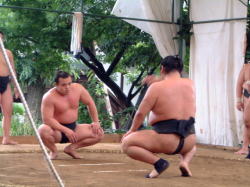 |
 |
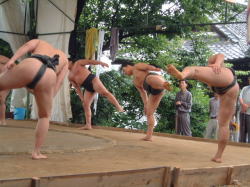 |
| sonkyo crouching posture, sitting on the heels, balanced on the balls of the feet, knees low, with an upright posture |
Gambatte ! | shiko sumo wrestler's basic practice/the movements of foot stamping |
SUMO
(JAPANESE WRESTLING)
SPIRIT * TECHNIQUE * BODY
 |
 |
 |
| sonkyo crouching posture, sitting on the heels, balanced on the balls of the feet, knees low, with an upright posture |
Gambatte ! | shiko sumo wrestler's basic practice/the movements of foot stamping |
Sumo is a traditional national sport of Japan.
You can watch the sumo tournaments called BASHO on TV, national channel,
six times a year.
1: Hatsu-basho (starts from the 2nd Sunday in January.) *** Tokyo (Ryogoku-kokugikan)
2: Haru-basho or Osaka-basho ( starts from the 1st or 2nd Sunday of March)
*** Osaka (furitsu-taiikukaikan)
3: Natsu-basho or Gogatsu-basho (starts from the 1st or 2nd Sunday of May)
*** Tokyo (Ryogoku-kokugikan)
4: Nagoya-basho (starts from the 1st or 2nd Sunday of July) *** Nagoya
(Aichiken-taiikukan, Aichi Pref. gymnasium)
5: Aki-basho ( start from the 1st or 2nd Sunday of September ) *** Tokyo
(Ryogoku-kokugikan)
6: Kyushu-basho (starts from the 1st or 2nd Sunday of November ) *** Fukuoka (Fukuoka-kokusai-center)
Each tournament lasts 15 days and each wrestler has one match a day
(each lower ranked wrestler has 7 matches in a tournament)
If a wrestler wins 8 out of 15 matches he'll have a winning record(KACHI-KOSHI),
and will get a higher rank in the next tournament..
Conversely, losing 8 out of 15 matches ( MAKEKOSHI ) makes a wrestler sink
to a lower rank.
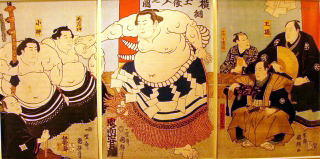 |
Approximately 200 matches are held in one day.
The lower rank wretlers (Jonidan-Makushita) fight 7 days and higher rank
wrestlers
(Juuryo - Yokozuna) fight 15 days.
The first match starts at 9:30 a.m. and the last match finishes around
6:00 p.m.
There are more than 700 sumo wrestlers and each of them
belongs to one of 44 HEYA (sumo stables or groups).
The relationship among the wrestlers in each stable is very tight
like a family, so they don't have matches
between two wrestlers from the same stable.
High ranking wrestlers can marry and live with their family,
but usually low rank single wrestlers live together in each stable's training
camps or Heya far from their family.
The boss of the stable is a retired high-ranking wrestler,
and his wife (OKAMISAN) takes care of all the wrestlers in a stable like
their mother .
....................................................................................................................................
| RANK | number of wrestlers | |
| Makunouchi (high rank wrestler) |
YOKOZUNA (Grand champion) |
1 |
| OZEKI | 4 | |
| SEKIWAKE | 2 | |
| KOMUSUBI | 2 | |
| MAEGASHIRA | 32 | |
| JUURYO | 28 | |
| MAKUSHITA | 120 | |
| SANDANME | 200 | |
| JONIDAN | 250 | |
| JONOKUCHI | 70 | |
( July 2010 )
.......................................................................................................................................
Japan sumo association keeps non-Japanese sumo wrestlers. They are from Mongolia, Russia, Tonga, China, Brazil, Estonia, Hungary, etc. In July 2007, there are 58 foreign wrestlers from 12 different countries, who are facing hard training, language barriers and cultural problems in order to adjust to the feudal sumo world.. Primarily they want to be sekitori. But I'm sure their real dreams and goals are to be strong and respectable yokozuna. Asashoryu and Hakuho from Mongolia are Yokozuna ( grand champion) now (July 2007) |
Tokusegawa from Mongolia June 24, 2007 (@Kiriyama-beya stable Nagoya quarter) |
,
Sumo wrestlers wear only MAWASHI or waistband-loincloth.
Their hair-style is like old samurai, topknots or MAGE.
Higher rank sumo wrestlers (upper Juuryo ) are allowed
to do up their hair in the Ooicho style.
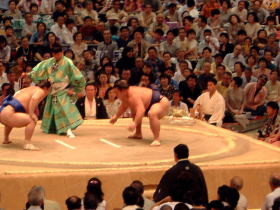 |
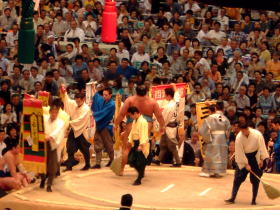 |
|
| gyoji / Sumo referee | before fighting, they do "shikiri" several times |
yobidashi and kensho advertisement |
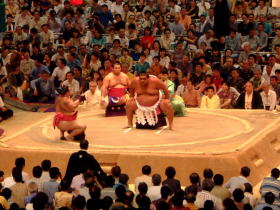 |
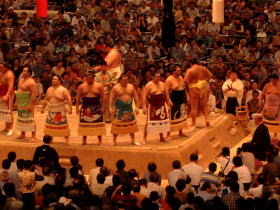 |
. |
| Yokozuna Dohyoiri | Keshou-mawashi / beautiful decorated apron | shiko |
**********
Sumo has been practiced for more than 1500 years, but
the current form developed in the Edo period.
| sumai no sechie | |
 |
|
|
|
| Sumo had been a part of Shinto ritual related to agriculture since ancient times. It later became related to the imperial rituals. In February or March, the Emperor sent kotorizukai (messengers for taking sumo players to the Imperial Court-they put moonflowers on their hair) who belonged to konoe-fu. In July of each year, sumo players were called to the Imperial Palace from all over Japan. This function was called "sumai no sechie" (Sumo was called "sumai" in old days).. It had been held on July 7th (the same day as tanabata), but Emperor Junna (786-840, reign:823-833) changed the date to July 16, because it was the same day as Emperor Heijo's memorial day. After that it changed again to July 28 . The Emperor watced uchidori (rehearsal of sumo) at Seiryo-den or Jijuu-den on July 26. They didn't have a dohyo (sumo wrestling ring) at that time. Sumo players wore tafusagi, kariginu and hakama. On 28th, they were divided into two groups and 17 to 20 matches were held in the garden of Shishin-den. If the left (left from the Emperor's seat)group won, "Ranryo-o"etc. were performed, and right group won"Nasori"etc. were performed. On the 29th, there was an exhibition match of the good wrestlers. |
| tickets The cheapest tickets will sell for 2,900yen (isu-jiyu-seki/an unreserved seat) 2014. They are sold only on the day at Toujitsuken-Uriba of Aichiken Taiiku-kan near Nagoya Castle from 8:00a.m. (Only 200 seats/day ?) |
Additional Info. *You can enter the venue from 8:15a.m. *No smoking *There is a temporary "chanko-yatai/ちゃんこ屋台"/chanko food stall, on the 2nd floor of Aichi Pref. Gym. They serve chanko for 300yen limit of 300 a day from 13:00. It's so popular that I suggest you to get them before 14:00. About re-entrance *Re-entry requires a stamp to the admission ticket. You can not re-enter without a stamped ticket. +Please re-enter through the group entrance. +Re-entry is permitted once per event.. *The sumo association prohibits the bringing in of food, drinks and any dangerous objects. |
Sumo wrestlers' quarters during the Nagoya-basho
Dohyo Matsuri
Sumo seat and Ticket
Hitori-zumo
Chanko
***
Sumo Association Official Website
![]()
*